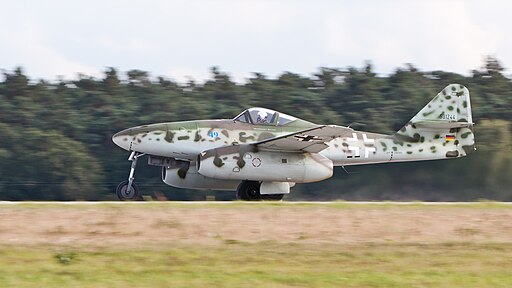The Messerschmitt Me 262, a dazzling emblem of innovation, emerged amidst the conflagration of World War II as the world’s first operational jet fighter. This aircraft’s impressive speed and lethal firepower, far outpacing its counterparts, have sparked intriguing speculation over the decades: could this remarkable piece of engineering have tipped the scales in Germany?
Before unraveling this historical conundrum, a nuanced understanding of the Me 262’s capabilities is necessary. The twin-engine jet fighter, a marvel in aeronautical design, was engineered to clock speeds upwards of 900 kilometers per hour, thereby outpacing the fastest Allied fighters by approximately 200 km/h. Armed with four MK 108 cannons, each 30mm in size, it was indeed an intimidating presence in the heavens above. Nonetheless, an analysis focusing purely on the aircraft’s specifications is woefully inadequate, given the complexity of wartime circumstances.
When the Me 262 began to grace the war-torn skies in mid-1944, the pendulum of war had already started swinging away from Germany. The historic Normandy invasion, launched by the Allies in June 1944, and the relentless pressure exerted by Soviet forces from the East had stretched the limits of German military power. The difficulties of producing, servicing, and operating an entirely novel breed of aircraft in such dire circumstances were colossal. Compounding these logistical issues were the jet engines of the Me 262, notoriously inconsistent and short-lived.
Adding to these impediments was a series of strategic missteps at the highest level of German command. Adolf Hitler’s initial decree that the Me 262 be used as a bomber rather than a fighter led to a diversion of critical resources and a costly delay in its deployment. By the time this decision was rectified, the sands of time had slipped away.
Even if these formidable hurdles had been surmounted, one must remember that dominance in the air is not the sole judge of wartime victory. Ground troops, naval capacity, economic resilience, and strategic insight are all crucial elements of a successful war campaign. By 1944, Germany was found wanting in all these areas. The enormous industrial prowess of the Allies dwarfed that of Germany, and their ground and naval forces were steadily advancing.
Equally noteworthy is the fact that the debut of the Me 262 spurred the Allies into immediate action. They evolved tactics to neutralize this novel threat, such as targeting the aircraft during its vulnerable takeoff and landing phases. Additionally, the advent of the Me 262 served to accelerate the pace of jet technology among the Allies, culminating in the creation of aircraft like the British Gloster Meteor.
Although the Messerschmitt Me 262 undoubtedly carves out a unique and extraordinary niche in the chronicles of aviation history, its potential to single-handedly alter the course of the war in favor of Germany seems improbable. The reasons underlying this conclusion are multifaceted and stem not from any deficiency in the aircraft’s innovative design but from the complex dynamics of World War II itself. The broader strategic panorama, the waning resources of the German military and economy, and the persistent and immediate reaction of the Allied forces were all instrumental in shaping the war’s final outcome. The Me 262, notwithstanding its groundbreaking speed and formidable firepower, could not overcome these factors.
For more insights into the Me 262 and other important military aircraft, visit Aces In Action. Here, you’ll find a relic plaque by Artist Craig Tinder that includes an illustration along with an actual relic of a Messerschmitt Me-262 that was recovered near the town of Olomouc, Czechoslovakia.
WWII Messerschmitt Me 262 Relic Plaque by Artist Craig Tinder
In May 1945, 4-meter aluminum sheets from an Me 262 production line were removed by a fleeing Czech worker to be used later as roofing material for his barns near the town of Olomouc, Czechoslovakia. This artifact was cut from one of those sheets in 2021, which still includes the original AWS (Aluminum Walzwerke Singen) manufacturer stamp marking – 3116.5.





Share:
Was the B-24 better than the B-17?
What is so special about the F-16?